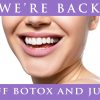Neuromuscular Orthodontics
Neuromuscular orthodontics is a term used to describe the inclusion of neuromuscular information in orthodontic evaluation and treatment planning.
Traditional orthodontics has focused almost entirely on the skeletal (bone) structure of the teeth, jaw, and jaw joints. The Neuromuscular Dentist used all of this information but also give careful study to the upper airway and the status of the muscles that control the posture and function of the jaw. By determining the cause of crooked teeth, airway problems and abnormal muscle forces can be corrected during treatment.
The goal is a balanced bite free of the muscle forces that might otherwise contribute to early relapse.
Why choose Neuromuscular Orthodontics?
Neuromuscular Dentistry brings a whole new dimension to treatment planning. In addition to traditional data, carefully studying the status of the muscles of the jaw and the condition of the upper airway helps to not only precisely evaluate where the teeth should be, but to better understand what caused them to be out of alignment.
Taking this added information into consideration, the underlying cause of the misalignment can be considered in the treatment plan. Neuromuscular dentist believe in removing the cause as part of the treatment, teeth can be moved more quickly, relapse is minimized if not eliminated, and the resulting bite is optimized as to function and comfort. The new bite is based on this expanded information and may also help to avoid extracting healthy teeth as part of the treatment.
What do muscles have to do with teeth?
The muscles of the mouth and the head and neck affect our dental health and may have far reaching effects on our overall health. The teeth are surrounded by muscle, the cheeks and tongue. The forces of the muscles can affect facial development, tooth alignment, head posture, the function of the jaw and can also be the source o various types of head and neck pain.
What causes abnormal muscle forces?
The way the teeth come together is part of a system of teeth, muscles, and joint. If the teeth don’t fit together properly, the muscles and joints will accommodate – work to get them together. This accommodation can often lead to muscles being at work when they should be at rest and the overworked muscles lead to other problems such as pain or an improperly aligned jaw joint. Successful treatment is dependant upon the dentist complete diagnosis of the current status of this system.
How does the upper airway affect the teeth?
If a person’[s ability to breath normally through the nose is restricted, it can have a marked influence on h bite. Allergies, asthma, deviated septum, enlarged tonsils or adenoids and other conditions all can lead to mouth breathing.
Excessive mouth breathing causes the tongue, a powerful muscle to exert abnormal pressure on the teeth and often cause the front teeth to move outward. This results in an open bite where the front teeth don’t touch even though the back teeth do. Developmentally a restricted airway in a young patient can contribute to narrowed dental arch and crowding of the teeth.
Because restricted nasal breathing often involves medical problems your dentist may refer you to other health specialists.
What has all this got to do with Orthodontics?
We consider total health
See all videos»
Constant muscle forces are powerful and can move teeth. A bad bite, poor posture, restricted airway, tongue habit, and other factors may cause muscle forces that adversely affect the occlusions. Not only may these forces have played a role in causing crooked teeth or an improper bite, failure to deal with them in orthodontic treatment may lead to premature relapse of the straightened teeth. In younger patients abnormal muscle forces can have a serious effect on facial development.
For more information visit www.myotronics.com










